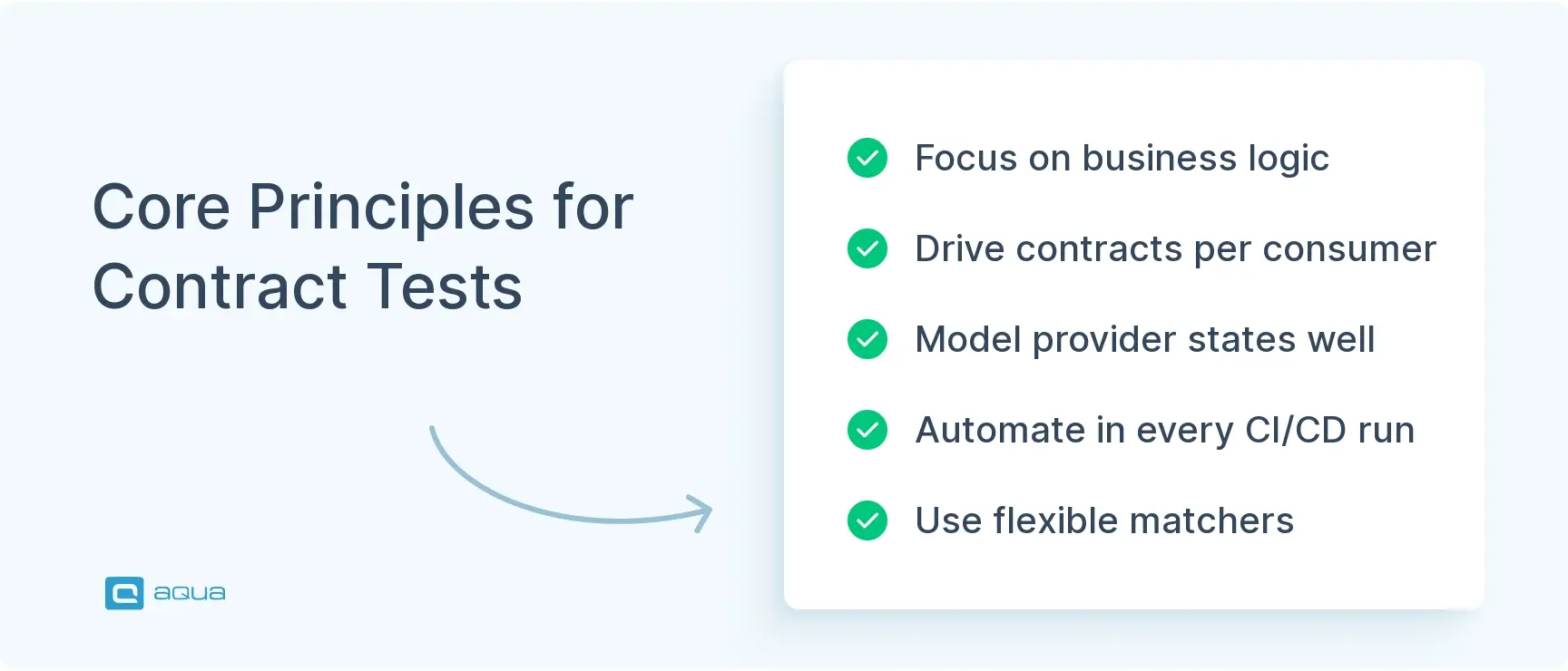Key takeaways
- Contract testing verifies communication between services by checking if they follow an agreed contract without requiring full integration environments.
- Pact, the standard contract testing tool, supports multiple languages and protocols through a workflow where consumers define expectations and providers verify compatibility.
- Contract tests run in minutes instead of hours, providing immediate feedback on API compatibility and clearer failure diagnosis without complex shared environments.
- Contracts serve as updatable documentation, deployment gates, and collaboration tools that prevent accidental breaking changes while facilitating API evolution.
- Effective contract testing requires focusing on business behavior, creating consumer-specific contracts, modeling realistic provider states, and integrating into CI/CD pipelines.
Contract testing cuts through the complexity by validating compatibility before services ever meet in production. Discover how this approach can transform your testing strategy and save your team hours of work 👇
What is Contract Testing?
Contract testing verifies communication between two services by checking if they follow an agreed “contract.” Think of a contract as the rulebook for their interaction: what requests look like, what responses should contain, what happens when things go wrong. Each service gets tested in isolation against this shared contract without needing to boot up the entire ecosystem.
Contract based testing works well in microservices and API-first architectures where dozens of services interact over HTTP, messaging queues, or gRPC. Traditional tests struggle here because coordinating all those moving pieces is slow and expensive. Contract tests solve this by being:
- Fast: No need to spin up entire environments
- Focused: Test specific consumer-provider pairs
- Precise: Catch compatibility issues right at the source
When something breaks, you know exactly where to look.
This approach works particularly well in consumer-driven contract testing, where consumers define what they need and providers must deliver. The contract captures real interactions:
- Allowed endpoints
- HTTP methods
- Required fields
- Data types
- Error behaviors
When a consumer’s code runs against a mock provider that speaks the contract, you know immediately if things match up. When the provider runs its verification against that same contract, you catch breaking changes before they hit staging.
Why Teams Struggle to Adopt Contract Testing
Contract testing sounds great in theory, but actually getting teams to use it? That’s where things get messy. The upfront investment feels daunting when your existing tests seem good enough. Plus, you’re dealing with cultural shifts, not just technical ones.
Common adoption barriers:
- Initial learning curve: Consumer-driven contracts and provider states take time to understand. Teams need to grasp the Pact workflow before they can write effective contract tests.
- Upfront work investment: You need to write consumer tests and set up a Pact Broker. Then comes configuring provider verification and integrating into CI/CD before you see any payoff.
- Cross-team coordination: Contract testing only works when both consumer and provider teams actually maintain the contracts. Getting everyone on board is tough.
- Unclear ownership: Who maintains the contracts? Who verifies them? Without clear responsibilities, contract tests turn into orphaned code that nobody wants to touch.
- Perceived redundancy: You already have integration tests running. Adding contract tests can feel like you’re just duplicating work.
- Tooling complexity: Setting up Pact and configuring the broker adds another layer to your testing setup. Managing provider states makes it even more complex.
Once teams push through that initial adoption phase and see contract testing catch real issues before production, the resistance usually disappears. The value hits home when you prevent your first outage or skip coordinating a massive integration environment just to validate one API change. Getting there takes management support, dedicated learning time, and patience while the investment pays off.
How Does Contract Testing Work? An Overview of Pact
Pact is the standard for contract testing tools, built around a simple but powerful workflow that connects consumers and providers through a shared contract repository.
The contract testing workflow:
- Consumer defines expectations: On the consumer side, you write tests that describe what your service expects from the provider. Pact spins up a mock server that behaves according to those expectations, and your consumer code hits that mock.
- Contract generation: If the consumer handles the interaction correctly, Pact generates a contract file. This JSON document captures every request and response pair.
- Contract publication: That contract gets published to a central repository called a Pact Broker or Pactflow, making it accessible to provider teams.
- Provider verification: The provider’s test suite pulls that contract from the broker and runs verification tests. It boots up the real provider implementation and replays each interaction from the contract, then checks if the provider’s actual responses match what the consumer expected.
- Results feedback: If the provider satisfies all the interactions, the verification passes, and the results go back to the broker, creating a complete feedback loop.
- Deployment validation: Before deploying, teams run a “can-i-deploy” check against the broker to verify all relevant contracts are satisfied. If they’re not, deployment gets blocked.
This workflow creates continuous validation where consumers define what they need, providers prove they deliver it, and both sides know instantly if compatibility breaks. Pact supports multiple languages including JVM, JavaScript, .NET, Ruby, Go, Python, and Swift. Thanks to the Pact v4 Plugin Framework, you can test protocols beyond HTTP such as gRPC, Protobuf, and Kafka-style messages, by using external plugins. The tool also uses provider states to set up data for each interaction, letting you test both happy paths and error scenarios realistically.
AI-powered contract testing now emerges in the market, letting organizations use machine learning to automatically detect patterns in API usage and suggest potential contract adjustments. This makes contract testing in action more powerful and efficient while turning contract testing into an explicit deployment gate for integration compatibility.
As modern software development centers around APIs and microservices, teams need effective contract testing. The right QA tools and processes set properly deliver real value. aqua cloud, an AI-driven test and requirement automation platform is designed specifically for teams that want to enhance their API and contract testing strategies. With aqua, you can centralize all your API test assets, from contract definitions to test results, in one unified repository. This ensures complete traceability between requirements and tests. aqua offers flexible integration capabilities. The domain-trained AI Copilot generates test cases from API specifications and requirements. This reduces test creation time by up to 97% while it maintains project-specific context and terminology. You can use popular tools like SoapUI and JMeter or specialized contract testing frameworks like Pact with aqua via REST API. The solution brings everything together through 12+ native integrations.
Achieve 100% test coverage across all your APIs and service contracts
Benefits of Implementing Contract Testing
Contract driven testing delivers tangible wins across speed, cost, and reliability. The shift from traditional integration testing to contract-based validation changes how teams work and how quickly they can move.
Traditional integration tests are a pain. You have to spin up multiple services, coordinate test data, and wait around for slow pipelines. As your system grows, this overhead just keeps piling up, creating bottlenecks that slow down your entire development cycle. Contract testing cuts through all that by testing specific consumer-provider pairs against mocks. Your teams can work in parallel without waiting for shared environments or coordinated deployments.
Key benefits:
- Faster feedback: Tests run in minutes instead of hours, giving developers immediate signals on API compatibility.
- Lower infrastructure costs: No need for shared environments or orchestrating dozens of services just to validate one integration.
- Clearer failure diagnosis: When a contract breaks, you know exactly which consumer and provider are involved. No log archaeology required.
- Safer refactoring: Providers can evolve APIs confidently because contracts document real consumer usage, not assumptions.
- Better team collaboration: Contracts become updatable documentation that both sides review and maintain together.
These advantages compound as your system grows. The more services you have, the more painful traditional integration testing becomes and the more valuable contract testing proves itself.
Example Contract
A contract is a structured description of how two services interact. Say you’ve got a payment service talking to an account service, where the payment service needs to check if an account exists before processing a transaction. Here’s what that contract might look like in Pact’s JSON format:
{
"consumer": {
"name": "PaymentService"
},
"provider": {
"name": "AccountService"
},
"interactions": [
{
"description": "a request for account details",
"providerState": "account 12345 exists",
"request": {
"method": "GET",
"path": "/accounts/12345",
"headers": {
"Accept": "application/json"
}
},
"response": {
"status": 200,
"headers": {
"Content-Type": "application/json"
},
"body": {
"accountId": "12345",
"balance": 1000.50,
"currency": "USD"
}
}
}
]
}This contract says the PaymentService expects to send a GET request to “/accounts/12345” with an Accept header, and the AccountService should respond with a 200 status and a JSON body containing “accountId”, “balance”, and “currency”. The “providerState` tells the provider’s verification test to set up the system so account 12345 exists before replaying this interaction. Pact uses matching rules e.g., patterns and time matechers, internally so you’re not locked into exact values. For example, “balance” could be any number and `currency` any three-letter string.
A contract testing template like this helps teams standardize their approach across different service pairs, making the adoption of contract testing software more consistent throughout the organization.
Contracts capture both happy paths and error cases. You’d add another interaction for “account does not exist” with a 404 response, ensuring the consumer handles that scenario correctly. These contracts are generated automatically from the consumer’s actual test code, so you’re not writing JSON by hand. The consumer test runs, exercise the real consumer logic, and Pact records what happened. That becomes the source of truth for what the provider must support, keeping the contract grounded in real usage rather than theoretical specs.
In my personal experience, contract testing with Pact has always worked very efficiently. Initially, teams may be hesitant to adopt it due to the required upfront work, but once they experience it, the value it provides is so significant that they usually end up being very satisfied with the outcome.
How Can Contracts Be Used for Contract Testing?
Contracts serve multiple roles beyond just running tests. They’re updatable documentation, deployment gates, and collaboration tools that change how teams work together.
Updatable Documentation and API Specifications
Contracts act as executable specs that prove your API actually works as described. Instead of a stale wiki page, you’ve got a contract that validates the API’s behavior on every build. Both teams can read the contract to understand what fields are required, what status codes might appear, and what error scenarios exist. If the contract test passes, that documentation is guaranteed to be accurate, eliminating the gap between what documentation claims and what the system actually does.
CI/CD Pipeline Integration and Deployment Gates
When a consumer or provider builds, CI runs contract tests automatically. Before deploying, teams use the broker’s “can-i-deploy” command to check if the new version is compatible with everything it needs to talk to. If contracts aren’t satisfied, the deployment gets blocked, turning contract testing into a hard gate for production releases. You’re not relying on manual coordination or hoping integration tests in staging catch issues. Compatibility is verified before code ships.
Team Collaboration and API Evolution
When a provider wants to change an endpoint, they can check the broker to see which consumers use it and what they expect. This visibility prevents accidental breaking changes. Consumers can define new interactions and publish contracts before the provider implements them, enabling parallel development. Providers can maintain overlapping support for old and new contracts during migration windows, giving consumers time to upgrade without blocking provider progress. The contract becomes a shared artifact that both sides actively review and update, keeping communication tight and reducing surprises.
Versioning and Environment Management
Contracts support versioning and environment management by letting you tag contracts with environment labels like dev, staging, or production. You know which versions are deployed where, letting you verify compatibility per environment. For example, you can ensure your new provider version works with the consumer currently in production before promoting it. Contracts also help with asynchronous workflows. If your services communicate via Kafka or SNS, you can define message contracts to validate payload structure and behavior the same way you would for HTTP.
A good contract testing tool should support this entire lifecycle, from contract creation to validation to deployment verification. The best contract testing software offers seamless integration with existing CI/CD pipelines and provides clear visibility into compatibility status.
Best Practices and Considerations for Contract Testing

Getting contract testing right requires more than installing Pact and running a few tests. You need solid practices to make contracts maintainable and valuable over time, ensuring they serve as reliable integration checkpoints rather than becoming another maintenance burden.
Core principles for effective contract testing:
- Design contracts around business behavior: Focus on the fields and responses that matter to the consumer’s use case. Avoid locking in internal metadata like timestamps or autogenerated IDs unless they’re genuinely required. Use Pact’s matching rules, such as patterns, type matchers, and array size constraints, to keep contracts flexible.
- Adopt consumer-driven contracts per consumer: Each consumer-provider pair should have its own contract. This keeps contracts focused on real usage and prevents a monolithic, hard-to-change contract that tries to please everyone. Consumers describe only what they use, so providers aren’t burdened with supporting features nobody needs.
- Model realistic provider states carefully: Provider states set up the provider for each interaction. Think “user exists” or “order not found.” These states let you test both success and failure scenarios without relying on external databases or shared test data. Make states meaningful and reusable across interactions.
- Integrate contract testing into CI/CD from day one: Run consumer tests on every consumer build and provider verification on every provider build. Use nightly runs or webhook triggers to verify providers against all relevant consumer contracts, and automate the “can-I-deploy” check before production deployments.
Without automation and clear ownership, contract tests lose their value by becoming manual checks that run sporadically or only on someone’s laptop. The goal is continuous compatibility checking that catches regressions immediately, not days later when someone remembers to run the tests.
Contract testing is a difficult practice to implement and scale. To make it work, you need dedication from the management and engineers. Contract testing is not a “magic pill."
Additional recommendations:
- Handle contract evolution backwards-compatibly: Add new optional fields instead of removing old ones. Providers can support both new and old contracts during transitions.
- Tag contracts by environment and version: Use tags like
prod,staging, orv1.2.3in the broker so you know which contracts apply where and when. - Review contract failures as a team: When a contract breaks, both consumer and provider teams should investigate together. This is a collaboration issue, not a blame game.
- Govern contracts lightly but consistently: Set naming conventions, versioning policies, and lifecycle rules so contracts don’t become chaotic as you scale.
- Extend to asynchronous and multi-protocol flows: Don’t limit contract testing to HTTP. Use Pact plugins or specialized tools for Kafka, gRPC, or WebSockets where integration bugs are even harder to trace.
These practices keep contract testing sustainable as your system grows. When done right, they catch issues early, document behavior accurately, and speed up your entire development cycle. Teams that follow these guidelines report significantly fewer integration issues in production and faster feature delivery cycles.
With contract testing, teams focus on reliable checks that catch compatibility issues early instead. To maximize the benefits described in this article, you need a test management system that supports this modern approach. aqua cloud, an AI-driven requirement and test management solutions, excels in complex API-heavy environments. It offers powerful features that complement your contract testing strategy. aqua gives you complete visibility across the lifecycle. The domain-trained AI Copilot sets aqua apart. It learns from your project’s documentation to generate relevant test cases and data. You get context-aware, project-specific outputs rather than generic AI suggestions. Combined with real-time dashboards that track contract compliance across environments, aqua changes how teams collaborate on API evolution and integration. Through automation integrations with tools like SoapUI and JMeter, along with custom workflow capabilities, aqua helps teams adopt best practices with minimal friction.
Save 97% of your time with AI-powered contract testing
Conclusion
Contract testing solves the chaos of microservices and API-heavy architectures by shifting integration validation left, catching breaking changes before they hit production, and giving teams fast, reliable feedback without the overhead of full-stack integration tests. By focusing on consumer-provider contracts, you replace slow, brittle end-to-end tests with targeted, parallelizable checks that run in minutes. Tools like Pact make implementation straightforward, and the ROI shows up quickly through faster pipelines, fewer production incidents, lower infrastructure costs, and better collaboration across teams. Start with one high-risk integration, prove the value, and scale from there.

















